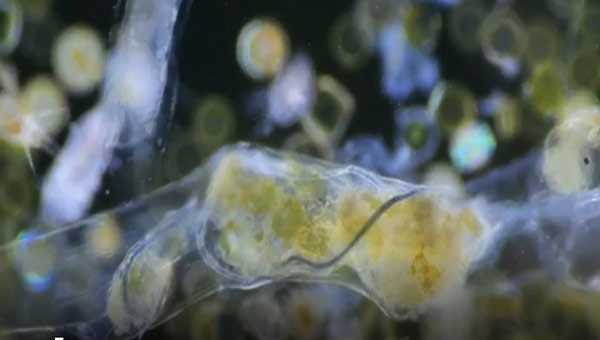
London, UK (BBN) - A scientist has filmed the moment plastic microfibre is ingested by plankton, illustrating how the material is affecting life beneath the waves.
The footage shows one way that waste plastic could be entering the marine and global food chain, reports BBC.
An estimated 150 million tonnes of plastic "disappears" from the world's waste stream each year.
Waste plastic in the world's seas has been recognised by the United Nations as a major environmental problem.
"When I saw it, I thought that here was something, visually, to convey to the public the problem of plastic in the sea," said Richard Kirby, who recorded the footage.
"What intrigues me is that because the fibre has made a loop inside the animal's gut, you can actually see the consequences of something as small as the arrow worm consuming microplastic.
Dr Kirby, a self-styled Plankton Pundit, said that people were familiar with the idea of large marine animals - such as whales, seals and birds - swallowing plastic bags.
"But here we have something where we actually see that at a tiny fibre has caused a blockage in something as small as a member of the plankton, stopping food progressing down.
"An arrow worm's gut extends for the whole length of its body, so this has stopped anything moving down the gut from about just below its head."
CHOKING OCEANS
Although Dr Kirby had witnessed the effects of microplastic on plankton before, this was the first time he had filmed it.
He added that this incident was not an isolated occurrence, saying that the sight of plankton ingesting plastic was a relatively common sight in the sample he had collected from British waters.
The issue of plastic waste in the marine environment has been rising up the political and policy agenda.
The United Nations has estimated that there are 46,000 pieces of waste plastic per square mile of sea.
The international body's environment agency, UNEP, has launched a #CleanSeas campaign.
Speaking at the launch of the campaign, the organisation's head, Erik Solheim, said: "It is past time that we tackle the plastic problem that blights our oceans."
He added that plastic waste in the ocean was allowing the material to enter the food chain.
Solheim stated: "We've stood by too long as the problem has gotten worse. It must stop."
The UN estimated that as many as 51 trillion (500 times as many stars estimated to be in our galaxy) particles of microplastic are in the world's seas and oceans.
The widespread presence of plastic in our waters meant that it was a problem for arrow worms, said Emily Baxter, senior marine conservation officer for the North West Wildlife Trusts.
"Their scientific name, Sagitta setosa, means bristle jaw, and that comes directly back to what they look like," she told BBC News.
"There are about 100 species worldwide.
In UK waters they tend to be about one to two centimetres in length.
She added: "They play a really important ecological role in the marine food web.
They are voracious predators of other planktonic animals and also represent an important food source for fish, squid and other things that eat plankton.
Dr Baxter said that the video posed a very worrying scenario.
"Even if we stopped producing plastic today this problem is going to continue for a long time.
We see it now coming into the bottom of the food chain and potentially affecting the food chain all the way up.
"That problem is not going to go away," she observed.
'GENIE OUT OF THE BOTTLE'
Dr Kirby said that the "genie was out of the bottle" and that this was visual evidence of the impact of plastic waste in the marine environment.
Previous studies have highlighted the problem of plastic waste in the world's oceans.
Researchers have voiced concern over the fact that plastic is listed as non-hazardous waste.
Dr Mark Browne, who has published numerous papers on the effects of plastic waste on the marine environment, said: "Plastic waste is infiltrating the ecosystem at a global scale and this video footage adds to the growing body of evidence showing that polymers are routinely ingested by animals.
"The key question remains: does this material cause ecological impacts and why are governments not using robust science to replace problematic products with safer alternatives?
"This could be done if they tasked ecologists and engineers to work together to identify and remove features of products that (if found as debris in habitats) might cause ecological impacts," he told BBC News.
"Similar approaches are already used to engineer infrastructure ecologically or to make less toxic 'biocompatible' medical devices."
BBN/MS/SK